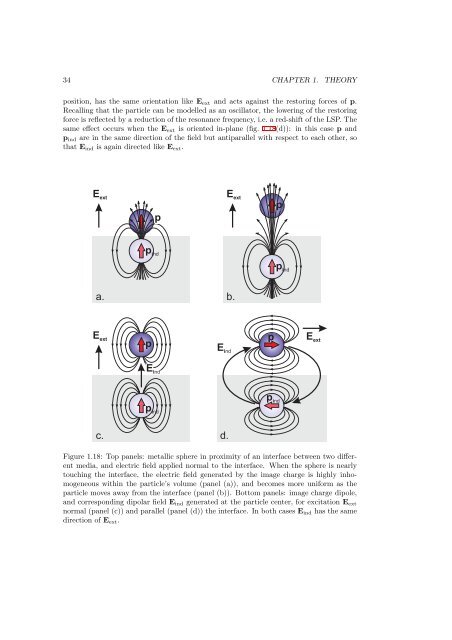Morphology and plasmonic properties of self-organized arrays of ...
Morphology and plasmonic properties of self-organized arrays of ...
Morphology and plasmonic properties of self-organized arrays of ...
Create successful ePaper yourself
Turn your PDF publications into a flip-book with our unique Google optimized e-Paper software.
34 CHAPTER 1. THEORYposition, has the same orientation like E ext <strong>and</strong> acts against the restoring forces <strong>of</strong> p.Recalling that the particle can be modelled as an oscillator, the lowering <strong>of</strong> the restoringforce is reflected by a reduction <strong>of</strong> the resonance frequency, i.e. a red-shift <strong>of</strong> the LSP. Thesame effect occurs when the E ext is oriented in-plane (fig. 1.18(d)): in this case p <strong>and</strong>p ind are in the same direction <strong>of</strong> the field but antiparallel with respect to each other, sothat E ind is again directed like E ext .E extp indpE extpp inda.b.E extpE indpE extE indp indp indc.d.Figure 1.18: Top panels: metallic sphere in proximity <strong>of</strong> an interface between two differentmedia, <strong>and</strong> electric field applied normal to the interface. When the sphere is nearlytouching the interface, the electric field generated by the image charge is highly inhomogeneouswithin the particle’s volume (panel (a)), <strong>and</strong> becomes more uniform as theparticle moves away from the interface (panel (b)). Bottom panels: image charge dipole,<strong>and</strong> corresponding dipolar field E ind generated at the particle center, for excitation E extnormal (panel (c)) <strong>and</strong> parallel (panel (d)) the interface. In both cases E ind has the samedirection <strong>of</strong> E ext .
















